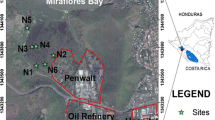Abstract
The sorption studies of Hg2+, CH3Hg+ and elemental mercury (Hg0) were carried out on lichen (Parmelia sulcata) and moss (Funaria hygrometrica) samples under laboratory conditions. Desorption studies with HCl indicate that inorganic mercury (Hg+2) and methyl mercury could be completely desorbed with 1 M HCl and 0.5 M HCl, respectively. Samples loaded with elemental mercury, however, needed 4–5 M HCl concentration for complete desorption of the adsorbed elemental mercury. When similar desorption studies were carried out with field samples collected around a thermometer factory with elevated levels of mercury (∼8 mg/kg), it was found that only about 10–15% of total mercury was desorbed with 1M HCl, while 4–5 M acid was required for complete desorption. We have tried to correlate this information to understand the transformations of mercury species that may occur either in the atmosphere or on the biomonitors. The results indicated that the elemental mercury, the principal form of mercury contamination around the thermometer factory, is converted into a strongly held form by some chemical binding agents on the surface of lichen/moss, or elemental mercury could diffuse into the cells of the lichen/moss, which then needs the stronger acid to release it. Sorption capacity studies suggest that the lichens and mosses can also be used as sorbent material for the decontamination of inorganic and methyl mercury from aqueous solutions.
Similar content being viewed by others
References
Aceto, M., Abollino, O., Conca, R., Malandrino, M., Mentasti, E., and Sarzanini, C., 2003: The use of mosses as environmental metal pollution indicators, Chemosphere 50, 333–342.
Al Asheh, S. and Duvnjak, Z., 1997: Sorption of heavy metals by moss, Adv. Environ. Res. 1(2) 194–212.
Aldrich, C. and Feng, D., 2000: Removal of heavy metals from wastewater effluents by biosorptive flotation, Miner. Eng. 13, 1129–1138.
Bacci, E., Gaggi, C., Duccini, M., Bargagli, R., and Renzoni, A., 1994: Mapping mercury vapours in an abandoned cinnabar mining area by azalea (Azalea indica) leaf trapping, Chemosphere 29(4), 641–656.
Balarama Krishna, M. V., Karunasagar, D., and Arunachalam, J., 2003: Study of mercury pollution near a thermometer factory using lichens and mosses, Environ. Pollut. 124, 357–360.
Balarama Krishna, M. V., Karunasagar, D., and Arunachalam, J., 2004: Removal of137Cs and90Sr from actual low level radioactive waste solutions using moss as phyto-sorbent, Separation and Purification Technology (in press).
Bargagli, R. and Barghigiani, C., 1991: Lichen bio-monitoring of mercury emission and deposition in mining, geothermal and volcanic areas of Italy, Env. Mon. Ass. 16, 265–275.
Che-Jen L. and S. O.Pehkonen 1999: The chemistry of Atmospheric mercury: A review, Atmos. Environ. 33, 2067–2079.
Clarkson, T. W., 1997: The toxicology of mercury, Crit. Rev. Toxicol. 34, 369–403.
Conti, M. E. and Cocchetti, G., 2001: Biological monitoring: Lichens as bioindicators of air pollution assessment: A review. Environ. Pollut. 114, 471–492.
Crist, R. H., Martin, J. R., Chonko, J., and Crist, D. J., 1996: Uptake of metals on peat moss: An in-exchange process, Environ. Sci. Technol. 30, 2456–2461.
Das, A. K., De la Guardia, M., and Cervera, M. L., 2001: Literature survey of on-line elemental speciation in aqueous solutions: A review, Talanta, 55 1–28.
Gardea-Torresdy, J. L., Tang, L., and Salvador, J. M., 1996: Copper adsorption by esterified and unesterified fractions of Sphagnum peat moss and its different humic substances, J. Hazard. Mater. 48, 191–206.
Jeran, Z., Jacimovic, R., Batic, F., and Mavsar, R., 2002: Lichens as integrating air pollution monitors, Environ. Pollut. 120, 107–113.
Karunasagar, D., Arunachalam, J., Rashmi, K., Navina, L. L., and Maruthi, M. P., 2003: Biosorption of inorganic and methyl mercury by inactivated fungal mass of Aspergillus niger, World J. Microbiol. Biotechnol. 19, 291–295.
Mason, R. P., Fitzgerald, W. F., and Morel, F. M. M., 1994: The biogeochemical cycling of elemental mercury: anthropogenic influences. Geochim. Cosmochim. Acta 58, 3191–3198.
Namasivayam, C. and Periasamy, K., 1993: Biocarbonated treated peanut hull carbon for mercury (II) removal from aqueous solutions, Wat. Res. 27(11) 1663–1668.
Porcella, D. B., Ramel, C., and Jernelov, A., 1997: Global mercury pollution and the role of gold mining: an overview. Water Air Soil Pollut. 97, 205–207.
Rio-Segade, S. and Bendicho, C., 1999: Ultrasound-assisted extraction for mercury speciation by the flow injection-cold vapour technique, J. Anal. At. Spectrom 14, 263–268.
Ruhling, A. and Tyler, G., 1968: An ecological approach to the lead problem. Bot. Notiser 121, 321–342.
Schroeder, W. H., Yarwood, G., and Niki, H., 1991: Transformation process involving Hg species in the atmosphere-results from the literature survey, Water Air Soil Pollut. 56, 653–666.
Sorensen, J. A., Glass, G. E., and Schmidt, K. W., 1994: Regional patterns of wet mercury deposition. Environ. Sci. Technol. 28, 2025–2032.
Tyler, G., 1989: Uptake, retention and toxicity of heavy metals in lichens, Water Air Soil Pollut. 47, 321–333.
Author information
Authors and Affiliations
Corresponding author
Rights and permissions
About this article
Cite this article
Krishna, M.V.B., Karunasagar, D. & Arunachalam, J. Sorption Characteristics of Inorganic, Methyl and Elemental Mercury on Lichens and Mosses: Implication in Biogeochemical Cycling of Mercury. J Atmos Chem 49, 317–328 (2004). https://doi.org/10.1007/s10874-004-1242-7
Received:
Accepted:
Issue Date:
DOI: https://doi.org/10.1007/s10874-004-1242-7




